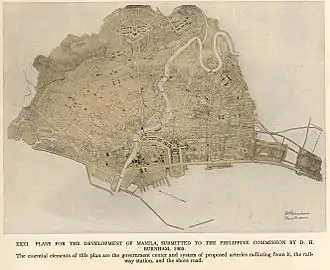William E. Parsons
William Edward Parsons (June 19, 1872 - December 17, 1939) was an architect and city planner known for his works in the Philippines during the early period of American colonization in the country. As the consulting architect to the Philippine government from 1905 to 1914, he designed various structures throughout the country, most notably the Gabaldon school building plans.
William Edward Parsons | |
|---|---|
| Born | June 17, 1872 |
| Died | December 17, 1939 (aged 67) |
| Nationality | American |
| Education | Yale University and École des Beaux-Arts |
| Occupation | Architect and city planner |
Biography
Parsons was born on June 1872 in Akron, Ohio.[note 1] He was educated at Yale University and École des Beaux-Arts in Paris.

During the early years of the American colonial era in the Philippines, former Governor-General of the Philippines (and future U.S. president), Howard Taft favored a comprehensive building construction and city planning in the country.[1] William Cameron Forbes, having recently appointed as commissioner to the Philippines, eventually sought out Daniel Burnham to create plans for developing the cities of Baguio and Manila.[2] Burnham and fellow architect Pierce Anderson drew up general preliminary plans based from site surveys in 1904 and 1905, free of charge on Burnham's end. The plans were followed by a recommendation of a well-trained architect for the Government's plan, as Burnham ended his involvement on the plans in the Philippines.[3][4]

Parsons was recommended by Burnham for the position, who at that time was practicing architecture in New York City, having recently graduated from École des Beaux-Arts, Paris. Parsons arrived at Manila in November 1905, tasked to "interpret" the preliminary plans prepared by Burnham and Anderson for Manila and Baguio, and modify these as needed. He would also supervise plans for building projects for the Bureau of Public Works.[5] Several public buildings and parks designed by Parsons are a hybrid of colonial architecture and that of the Philippines, which is a tropical country. Such designs also adopted the use of local material, such as hardwoods and capiz shells for window sash in place of glass to reduce sunlight glare.[6]
Parsons also prepared the standardized plans of the Gabaldon school buildings, which were designed akin to templates with the intent of promoting efficiency in the planning process.[7] These are school buildings constructed in the Philippines between 1907 and 1946 and named after the late assemblyman Isauro Gabaldon of Nueva Ecija, who authored the Gabaldon Act which appropriated P1 million for the construction of modern public schools nationwide.[8]
Due to apparent political reasons, Parsons resigned in 1914, and he was succeeded by George Corner Fenhagen as the Consulting Architect of the Philippine government. He died on December 17, 1939 at his home in New Haven, Connecticut, survived by his wife and two children.[9][10]
Works
- Gabaldon School Buildings
- Customs Office, Cebu City
- Manila Army and Navy Club Building, Manila
- Manila Elks Club, Manila
- Manila Hotel, Manila
- Paco railway station, Manila
- Philippine General Hospital
- H.A. Bordner Building, Manila Science High School
- Philippine Normal School
- Provincial Capitol (Old) of Laguna Province in Santa Cruz, Laguna
- Provincial Capitol (Old) of Nueva Ecija in Cabanatuan City
- University Hall of the University of the Philippines Manila
- The Mansion House, Baguio[11]
- Provincial Capitol (Old) of Capiz Province in Roxas City, Capiz
- Casa Gobiyerno in Dumaguete[note 2]
See also
Notes
- His tombstone uses June 19, 1872; likely the baptismal date. June 17, 1872 comes from the transcription of Ohio Births and Christenings, 1821-1962. The discrepancy may been a transcription error.
- Casa Gobiyerno was built in 1920 and demolished in 1935.
References
- Bronson, Rea (1906). "Details and description of the Burnham plans for the reconstruction of Manila". The Far Eastern Review. 3 and 4: 322 – via Google Books.
- "Notes: Mr. Burnham in Manila". Architectural Record. 17: 77. 1905. hdl:2027/mdp.39015033430086 – via HathiTrust Digital Library.
- Robinson, Charles Mulford (1905). "New Dreams for Cities". Architectural Record. 17: 421. hdl:2027/mdp.39015033430086 – via HathiTrust Digital Library.
- Hines, Thomas S. (1972-02-01). "The Imperial Façade: Daniel H. Burnham and American Architectural Planning in the Philippines". Pacific Historical Review. 41 (1): 33–53. doi:10.2307/3638224. ISSN 0030-8684. JSTOR 3638224.
- Governor general, Philippine Islands (1908). "Report of the governor general of the Philippine Islands". Retrieved 2020-12-02.
- Rebori, A.N. "Architectural record v.41 1917 Jan-Jun". Architectural Record. 41: 305–324. hdl:2027/mdp.39015033430185 – via HathiTrust Digital Library.A.N. Rebori (1917-04). }}
- Philippine Commission (1906), Seventh annual report of the Philippine Commission, part 2, pp. 198, 365–370, retrieved 2020-11-26
- Engalla, Jay-lleen (August 3, 2015). "Restoring Gabaldon Schoolhouses".
- "Architect and Educator, William E. Parsons, Dies". Detroit Free Press. Associated Press. December 18, 1939. Retrieved 2018-05-21.
- "Collection: William E. and Myra L. Parsons papers". archives.yale.edu. Retrieved 2020-11-26.
- "Mansion House (Presidential Museum and Library)". Retrieved 2020-11-27.